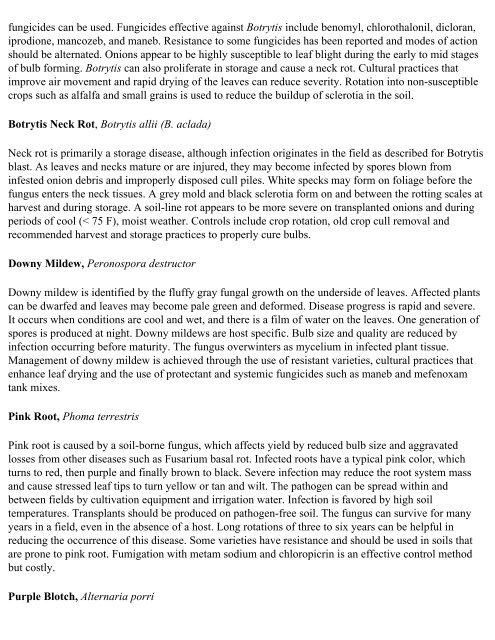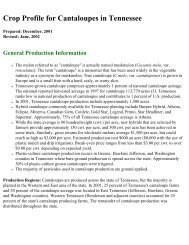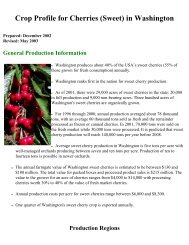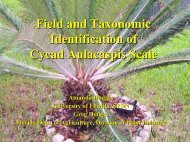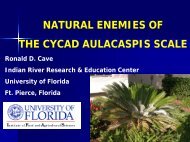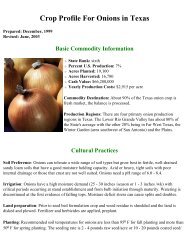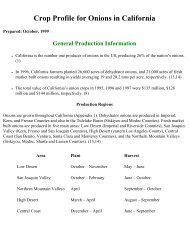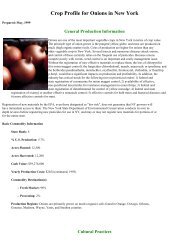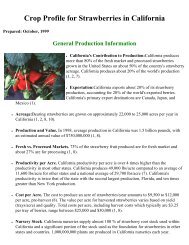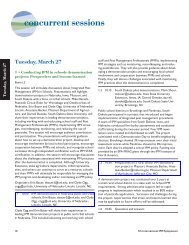Crop Profile for Onions in Colorado - Regional IPM Centers
Crop Profile for Onions in Colorado - Regional IPM Centers
Crop Profile for Onions in Colorado - Regional IPM Centers
You also want an ePaper? Increase the reach of your titles
YUMPU automatically turns print PDFs into web optimized ePapers that Google loves.
fungicides can be used. Fungicides effective aga<strong>in</strong>st Botrytis <strong>in</strong>clude benomyl, chlorothalonil, dicloran,<br />
iprodione, mancozeb, and maneb. Resistance to some fungicides has been reported and modes of action<br />
should be alternated. <strong>Onions</strong> appear to be highly susceptible to leaf blight dur<strong>in</strong>g the early to mid stages<br />
of bulb <strong>for</strong>m<strong>in</strong>g. Botrytis can also proliferate <strong>in</strong> storage and cause a neck rot. Cultural practices that<br />
improve air movement and rapid dry<strong>in</strong>g of the leaves can reduce severity. Rotation <strong>in</strong>to non-susceptible<br />
crops such as alfalfa and small gra<strong>in</strong>s is used to reduce the buildup of sclerotia <strong>in</strong> the soil.<br />
Botrytis Neck Rot, Botrytis allii (B. aclada)<br />
Neck rot is primarily a storage disease, although <strong>in</strong>fection orig<strong>in</strong>ates <strong>in</strong> the field as described <strong>for</strong> Botrytis<br />
blast. As leaves and necks mature or are <strong>in</strong>jured, they may become <strong>in</strong>fected by spores blown from<br />
<strong>in</strong>fested onion debris and improperly disposed cull piles. White specks may <strong>for</strong>m on foliage be<strong>for</strong>e the<br />
fungus enters the neck tissues. A grey mold and black sclerotia <strong>for</strong>m on and between the rott<strong>in</strong>g scales at<br />
harvest and dur<strong>in</strong>g storage. A soil-l<strong>in</strong>e rot appears to be more severe on transplanted onions and dur<strong>in</strong>g<br />
periods of cool (< 75 F), moist weather. Controls <strong>in</strong>clude crop rotation, old crop cull removal and<br />
recommended harvest and storage practices to properly cure bulbs.<br />
Downy Mildew, Peronospora destructor<br />
Downy mildew is identified by the fluffy gray fungal growth on the underside of leaves. Affected plants<br />
can be dwarfed and leaves may become pale green and de<strong>for</strong>med. Disease progress is rapid and severe.<br />
It occurs when conditions are cool and wet, and there is a film of water on the leaves. One generation of<br />
spores is produced at night. Downy mildews are host specific. Bulb size and quality are reduced by<br />
<strong>in</strong>fection occurr<strong>in</strong>g be<strong>for</strong>e maturity. The fungus overw<strong>in</strong>ters as mycelium <strong>in</strong> <strong>in</strong>fected plant tissue.<br />
Management of downy mildew is achieved through the use of resistant varieties, cultural practices that<br />
enhance leaf dry<strong>in</strong>g and the use of protectant and systemic fungicides such as maneb and mefenoxam<br />
tank mixes.<br />
P<strong>in</strong>k Root, Phoma terrestris<br />
P<strong>in</strong>k root is caused by a soil-borne fungus, which affects yield by reduced bulb size and aggravated<br />
losses from other diseases such as Fusarium basal rot. Infected roots have a typical p<strong>in</strong>k color, which<br />
turns to red, then purple and f<strong>in</strong>ally brown to black. Severe <strong>in</strong>fection may reduce the root system mass<br />
and cause stressed leaf tips to turn yellow or tan and wilt. The pathogen can be spread with<strong>in</strong> and<br />
between fields by cultivation equipment and irrigation water. Infection is favored by high soil<br />
temperatures. Transplants should be produced on pathogen-free soil. The fungus can survive <strong>for</strong> many<br />
years <strong>in</strong> a field, even <strong>in</strong> the absence of a host. Long rotations of three to six years can be helpful <strong>in</strong><br />
reduc<strong>in</strong>g the occurrence of this disease. Some varieties have resistance and should be used <strong>in</strong> soils that<br />
are prone to p<strong>in</strong>k root. Fumigation with metam sodium and chloropicr<strong>in</strong> is an effective control method<br />
but costly.<br />
Purple Blotch, Alternaria porri


